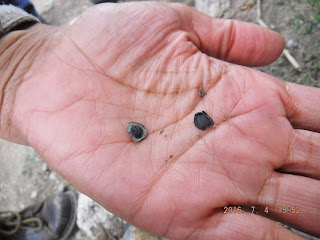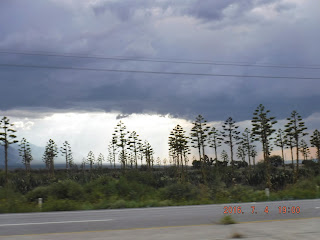I spent my 4th of July in the ejido in Coahuila that I first visited this summer to do an interview with the comisariado (leader), this time to do my first focus groups. However, I ended up doing a sort of impromptu interview and ejido tour with the comisariado and the man in charge of their new agave program, as well going with them to visit another nearby ejido that is participating in the new agave program. Not exactly what I had planned, but during our over two-hour conversation I learned a lot about the agave program. They have received funding from the Mexican federal government to plant agaves for making agua miel and “destilado” (basically mezcal that can’t be called “mezcal” given that the state of Coahuila is not within the Denomination of Origin for mezcal and therefore producers in this state are not legally allowed to sell their distilled agave product as “mezcal”). Through this program they recently built a new distillery for making the destilado. There are several other ejidos in the area that also harvest agaves and bring them to this distillery to make the product. They will be exporting their product to other countries, including the US. Unfortunately, they didn’t have any available to try, but I hope I’ll be able to buy a bottle once they start selling!
The first bottle of "destilado" made as part of the
ejido's new agave program. They will be sending it
to a university laboratory to have the contents tested
so they can establish a standard for their product.
However, they did give me some of the community’s agua miel to try. It tasted very different from the first one I tried in Rayones. This one didn’t have the same really sweet flavor, and instead tasted a bit like corn (and if you had asked me to identify what it was based on the smell alone, I would have said it was corn on the cob). I asked if they added any corn products to it and he said no. It was crazy how much it smelled like corn though! I still really liked it, despite the significant difference. The comisariado said it was because they use a different species than the people in Rayones, and it’s also partly due to the different soil and environment in this community (drier, semi-desert) versus Rayones (wetter, in the mountains, with lots of trees). The comisariado also gave me a bottle of “jarabe de agave” (agave syrup) to take home. In this ejido they call this product “jarabe” (syrup) but in another community in the mountains of southern Nuevo Leon they call the same product “miel de maguey” (agave honey) or “miel espesa” (thick honey). It’s really interesting to see the cultural differences between the communities!
Our first stop on our “tour” was a little patch of agave
seedlings that were planted next to a house. They were so tiny! Definitely not
what I was expecting them to look like. This was my first time seeing
seedlings. In all the other communities I’ve only seen “hijos” (the young
plants that grow from the base of an older agave and are clones of that agave),
since all of the other ejidos I’ve talked to replant these “hijos” instead of
the seeds.
Oh so little agave seedlings!
Two agave seeds
Agave seedlings sprouting, with the seed coverings
still attached to some.
Our next stop was the ejido’s “vivero” (nursery), where they
will be planting and raising their seedlings, which will then be transplanted
into the community’s land to grow and be harvested in 6+ years. They will be
planting several thousand seeds, so I can only imagine what this nursery will
look like once the seedlings are growing!
The ejido's vivero (nursery), where they will be planting
thousands of agave seeds for their new program.
After our stop at the vivero, we headed to another nearby
ejido to talk with a man involved in agave harvest there. This ejido also harvests
agaves, but for different uses. Their main use of agaves is to make “golosina”
(candy) from the cooked “quiotes” (stalks) from around April through November.
They cut the stalks of the agaves and bake them in earthen ovens dug in the ground.
They then sell the candies in nearby towns and cities. Several people in this
ejido also work the agaves for agua miel and pulque (fermented agua miel)
year-round. However, the demand for agua miel is not as great as the candies,
so not as many people harvest agaves for this purpose. The community members
also cut the agave stalks and feed the flowers to their livestock in times of
drought when there is not enough forage for the animals.
This dead/dying-looking agave (with most of
the leaves cut from the base) has been sitting on
the ground for a year, but will still grow once
planted. Crazy!
Chopped agaves waiting to be re-planted.
The earthen horno (oven) where they cook
the quiotes for golosina (candy) to sell
in nearby towns and cities.
Half of a dried quiote
After over two hours of talking and touring, we drove back
to the original ejido. I had a few moments of sheer panic when, on the ride back,
my voice recorder fell off the console and onto the floor in the truck. I
picked it up and it had turned off. I was SO worried that this would be a
repeat of what happened with the camcorders (where if the camcorder battery
dies and the camcorder shuts off before you physically hit the “stop” button
the recording nothing gets saved) and that I would have lost all two hours of
our conversation, but I lucked out and the recording was saved and all there.
That was my first encounter with almost losing data (well, at least during my
PhD) and it reminded me that periodically stopping the recording and starting a
new one is always a good policy...
Once back at the ejido we parted ways, at least until my
next visit later this week. We (Josefo, Isra, Ana, and I) stopped at the
Brazilian restaurant in Saltillo that is our go-to place on the way home from
this ejido, and my tummy was once again filled to the brim with over 10 meats
that I have no idea what they are in English. I also got to try a “michelada”,
a beer concoction that can contain a variety of things, including soy sauce,
salt, lime juice, and hot pepper sauce. Not my favorite, but it was better than
the “climato” that I tried last year with beer, tomato juice, and clam juice. We
had another battery incident with the truck (it didn’t have any juice at all
when we left the restaurant) but we managed to push it down the parking lot and
get it started. My first time having to jump start a car like that!
This visit went A LOT better than the first time I visited
this community (and did my first ever interview with the comisariado). The first time doing any interview, I felt so nervous and I tried to ask the
questions in Spanish, even though my Spanish wasn’t great. This time, although
I am by no means great at Spanish, I was MUCH BETTER with the language and was
able to easily converse with them, and I understood them a lot better too. I
think it’s partly because they enunciated very well when speaking and spoke at
a speed that I could handle, but also because my Spanish abilities have
definitely improved. I guess all those days of fretting about the language barrier
are starting to pay off! This visit was definitely jam-packed with learning
(and food!) and I’m really looking forward to going back later this week to
(hopefully) do some focus groups. Fingers crossed it all works out!
A bunch of flowering agaves on the side of the highway.
I may not like how the rain always tries to
mess with my plans, but it sure does provide
Sunset on the drive home.













No comments :
Post a Comment